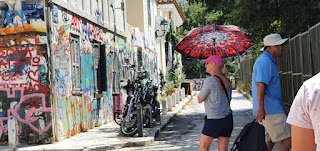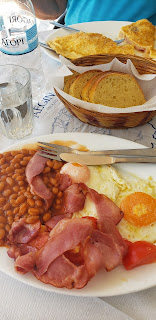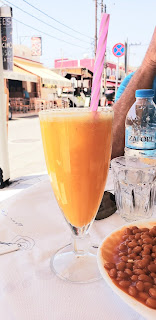It was a perfectly lovely way to end a great day.
 |
| The view was even better after dark. |
The Acropolis of Athens is no small place. It is located right in the heart of Athens, high up on a hill. One of the other families attending the wedding had planned for a private guide and we were very excited to be invited to join them touring the Acropolis.
Parking at the metro was a challenge. We finally found an opening and it was humorous to see several members of our group helping LW pull the van into the very, very small spot. I was so engrossed watching them, I completely forgot to take a photo.
There is a great article about the Athens Metro on Wikipedia.
The Athens Metro is a rapid-transit system in Greece which serves the Athens urban area and parts of East Attica. Line 1 opened as a conventional steam railway in 1869 and electrified in 1904. In 1991, Attiko Metro S.A. constructed and extended Lines 2 and 3. It has significantly changed Athens by providing a much-needed solution to the city's traffic and air pollution problem, as well as revitalizing many of the areas it serves.
After a short walk from the Metro, we were at the entrance to the Acropolis. Previously in 2014, Hubby D and I visited Greece and hiked up the mountain to the Acropolis. This was prior to my knee surgery in 2020. I remember it was a hard climb for me. This time it was a different story. The climb was SO MUCH easier, but still a climb.
The Acropolis, a rocky hill in the center of the city of Athens is the site of four of the greatest masterpieces of classical Greek art – the Parthenon, the Propylaea, the Erechtheum and the Temple of Athena Nike.
 |
| The Parthenon |
The main temple is the Parthenon. According to www.History.com, construction of the Parthenon began in 447 B.C. Its design is credited to two architects, Ictinus and Callicrates, as well as the sculptor Phidias. Ancient and modern observers alike have marveled at the sophisticated techniques used to construct the temple, which mixed the Doric and Ionic styles of classical Greek architecture to stunning effect. It was also impressive that it only took 9 years to complete.
One interesting fact our guide shared with us was though the Parthenon looks perfectly straight and symmetrical, in fact it is subtly curved, beginning at the foundation and running up through the steps, colonnade and even the roof. Rather than a settling of the blocks over time, this was an effect the temple’s builders deliberately created—through techniques like beveling or angling the blocks of the steps, tilting the columns slightly inward and making the corner columns slightly thicker than the others. In addition, the columns have a slight swelling near the middle, known as entasis.
I researched this and found that the Roman architect Vitruvius argued that such refinements were made to counter the effects of an optical illusion: When viewed from a distance, a perfectly straight line would appear to sag, whereas the temple’s curvature would counteract that illusion.
“Athens under Pericles wanted to promote itself as the greatest of Greek cities,” is a quote from Jeffrey Hurwit, a professor emeritus of art history and classics at the University of Oregon and author of The Athenian Acropolis. Hurwit suggests another, more artistically motivated reason for the refinements.
“A building as large as the Parthenon that was perfectly straight, with perfect horizontals and perfect verticals, would appear less interesting visually than a building that has these deviations, which are at first sensed rather than actually seen or experienced,” he says. “It seems more active this way. The Parthenon is a building, but it's also almost a sculpture.”
I agree, it is very much like a sculpture sitting high on that rugged hill.
After 1,000 years as the religious center of Athens, the Acropolis was transformed into a Christian place of worship in the fifth century A.D., under the rule of the Romans and Byzantines. After the Ottoman conquest in the 15th century, it was used as a mosque. By the time Greece won its independence in the 19th century, the buildings of the Acropolis were heavily damaged, but still standing.
Limited investigation of the site took place in 1835 and 1837, while in 1885-1890 the site was systematically excavated. The first large-scale restoration project started in the early twentieth century. A Committee for the Conservation of the Monuments on the Acropolis was created in 1975 with the aim to plan and undertake large-scale conservation and restoration on the Acropolis. The project is still in progress.
Here is a video I shot from the top of the Acropolis in 2014. It appears very much the same now. Unfortunately the video I took on this visit did not come out very good. If you are reading this in an email, you will need to go to this blog post to view the video. https://brendahyde.blogspot.com
Atop the Acropolis stands an olive tree that our guide pointed out to us. There is an interesting article about it on the Olive Oil Times web site. Although this is not the ‘original’ tree honored by pious Athenians over 2,500 years ago, it nonetheless stands in roughly the same spot as the original.
The tree was an important foundation myth for Athens as it established the importance of the goddess Athena for the city that took her name.
Legend has it that Zeus offered a contest between Athena and Poseidon for the possession of Athens. Poseidon raised up his three-pronged trident, smashed it upon the hard rock of the Acropolis and out a salt spring sprang. Athena on the other hand produced an olive tree, its rich fruits bountifully dangling from the branches. This dramatic showdown between the two powerful Olympians was immortalized in stone, depicted on the West pediment sculptures of the Parthenon. It is also the theme of many oil paintings.
This is a 1696 painting by René-Antoine Houasse depicting the conflict and it hangs in Château de Versailles.
The Athenians chose Athena’s gift and the olive tree has remained a central part of Greek life.
The olive tree on the Athenian Acropolis holds extra importance compared to all others in Greece due to its divine provenance. When the Great King Xerxes’ Persian armies swept through Greece and sacked Athens in 480BC, the buildings on the Acropolis were set on fire and destroyed. Yet Herodotus tells us that the olive tree ‘sprouted the same day to a height of 3 ft.
Seeds from the remnants of this tree were replanted across Attica (area where LW and YW live) and in this way, all the olive groves surrounding Athens have a touch of Athena’s original tree in them.
 |
| After we walked down off the Acropolis, we came across this graffiti. Graffiti is all over Athens. |
The next day we embarked on a road trip as YW gave us a tour of some very interesting areas.
Our first stop was the Isthmos Canal. Hubby D really enjoyed seeing this feat of engineering.
The idea of building a canal through the Isthmus of Corinth (which connects the Peloponnese to the rest of Greece) was conceived by the tyrant Periander in the sixth century BC to link the Ionian and Aegean Seas. Its completion, however, didn't come about until the late 1800s after modern Greece gained independence.
Today, the Isthmos Canal (also known as the Corinth Canal) which is four kilometers east of modern Corinth, is the city's top attraction. Creating it between 1882 and 1893 involved an excavation up to 80 meters in depth to create a canal that is 6.3 kilometers long, 23 meters wide, and eight meters deep and can accommodate vessels of up to 10,000 tons.
At the ancient city of Corinth, we stopped in the museum to see the sculptures and then tour the ancient ruins. There were some good examples of columns and capitals. A capital is the crowning, decorative part of a column that transitions from the main structure to the supporting masonry. As relics of the Classical world, they can help to date buildings and understand architecture.
Doric, Ionic and Corinthian are the primary type of capitals found in classical Greek columns. Our guide at the Acropolis told us if you ever saw a Corinthian capital, it had to be built by the Romans. Greeks only built Doric and Ionic capitals.
In the museum had many statues.
In the middle of the ancient ruins is a complex marble structure associated with the trial of Apostle Paul in Corinth after he spent time preaching to the Corinthians.
 |
| Here is Hubby D at the site of the trial of Apostle Paul. |
Our final stop was for sunset at Acrocorinth (also spelled Akrokorinth) which lies 3.5 kilometers south of Ancient Corinth.
 |
| This is a small portion of the photo above enlarged. KU was peering inside the gate. |
The ascent to the top of this impressive, fortified hilltop (575 meters) is made easier by a road, which climbs to a point near the lowest gate on the west side. Acrocorinth was fortified in ancient times, and its defenses were maintained and developed during the Byzantine, Frankish, Turkish, and Venetian periods, so that its walls now measure almost two kilometers in length.
The view from this area was quite breathtaking.
While we were enjoying the sunset, a couple drove up and started taking video with a drone. Here is a video they took of our group standing on the hill in front of the fort of Acrocorinth. If you are reading this in an email, you will need to go to this blog post to view the video. (It is really impressive.) https://brendahyde.blogspot.com
After sunset at Acrocorinth, we had another WONDERFUL dinner across Korinthos Bay in Loutraki by the waterfront.
 |
| At this dinner, I discovered a new favorite -- fried cheese! |
Whew! I didn’t realize how much we had done until I started writing this blog. WOW – we were busy!
During our final week we would be in Santorini. On Monday, we drove 2 cars to the port of Rafina to board a ferry.
 |
| The port of Rafina was the same port we sailed out of in 2014 to go to Mykonos. Not much had changed. |
From the ferry we could see numerous small sail boats and cruising vessels. There are endless opportunities to cruise the Greek islands. Every time I looked out to the water; I saw boats sailing by. Hubby D and I decided it would be great to sail the islands in a catamaran.
We were fortunate to travel to Santorini in 2014 and both of us could not wait to visit the island again. I will blog about this final week of our awesome adventure in my next segment.
Cheers,
Brenda Hyde
 |
| The beautiful sunset at Acrocorinth. |




























































































